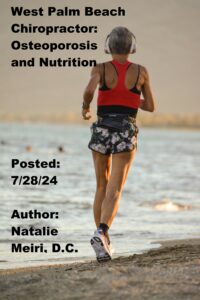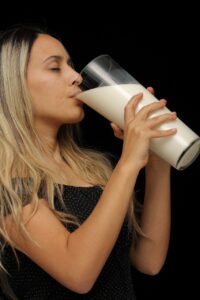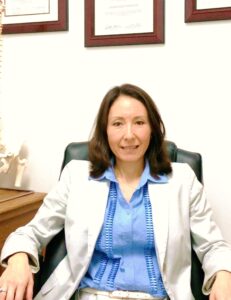
Did you know the signs of osteoporosis often appear suddenly with the development of a painful kyphosis (hunchback) or hip fracture? Astoundingly, over half of women over age 50 years will have a fracture due to osteoporosis. And it is estimated over 1.3 million number of fractures will be due to osteoporosis with an enormous cost. However, 50% of osteoporotic hip fractures and 90% of vertebral spinal compression fractures are preventable. Your Bone Mass should not be thought of only in an emergency, but should be a lifelong striving for preservation and development. Read West Palm Beach Chiropractor: Osteoporosis and Nutrition to learn about how to have healthy bones.
West Palm Beach Chiropractor: What is Osteoporosis?
Firstly, Osteoporosis is a loss of bone mass associated with deterioration of the microarchitecture (structure and connectivity of bone elements and the thickness of the cortical shell) of bone tissue.
Secondly, Osteoporosis is typically divided into bone loss associated with age, called senile osteoporosis (type II) and postmenopausal osteoporosis (type I). Of course, Women can get both types.
Thirdly, generalized (whole body) osteoporosis is the most common form found with both senile and postmenopausal causes. A regional osteoporosis may occur that is restricted to a bone or part of a limb. This can be found with immobilization and Sudeck’s atrophy (associated bone changes found with reflex sympathetic dystrophy). Moreover, regional/localized osteoporosis may occur in certain areas of bone as a result of infection, cancer, or an inflammatory arthritis.
West Palm Beach Chiropractor: Osteoporosis classification/diagnosis
Radiographically (x-ray), osteoporosis is classified based on the area or region found. The classification of Osteoporosis is often primary or secondary. Primary causes include senile and postmenopausal types. And secondary causes include hormonal dysfunction such as hyperthyroidism and hyperparathyroidism. So the thyroid gland uses iodine from food to make two thyroid hormones that regulate the way the body uses energy. While the parathyroid glands are four tiny glands located behind the thyroid gland. The parathyroid glands produce a substance (parathyroid hormone) that helps control the amount of calcium in the blood.
The World Health Organization distinguishes the degree of loss of bone mass by two terms:
- osteopenia-bone density greater than 1 standard deviation (SD) below the normal mean but less than or equal to 2.5 SD below the normal mean
- osteoporosis-bone density greater than 2.5 SD below the normal mean

West Palm Beach Chiropractor: Anatomy and Physiology of Osteoporosis
First, Osteoporosis occurs due to loss of bone quantity without an associated decrease of bone quality (mineralization is normal). It appears there is increased resorption in the process of bone formation. Indeed, the process of bone formation and resorption is a delicate balance. And environmental, nutritional, and hormonal factors are all involved in this. While genetics play a huge part in bone mass variation, lifestyle is still essential.
Second, Production of bone exceeds resorption (bone breakdown) in early life. Next, the production of bone peaks during and after puberty. Gradually, the production does decline during the mid-20s to early 30s. After this, a small period of balance occurs when production equals resorption. Especially in women, an imbalance in favor of resorption begins in the late 30s and early 40s. The fact is, the rate of bone loss is greater in women than in men in a lifetime. Men only lose 25% of bone mass while women lose 50%. Decreases in estrogen at menopause causes cortical bone loss and therefore increases the risk of fracture.
Third, Bone is composed of two thirds mineral (mainly hydroxyapatite, a mineral composed of phosphorus and calcium). The remaining one third is collagen, water, proteoglycans (type of protein), and other noncollagenous proteins. Type I collagen acts as a framework for deposition of minerals. The process of bone formation and repair is determined by an interaction of three cell types: osteoblasts (form collagen), osteocytes (coordinate bone formation function), and osteoclasts (break down bone).
West Palm Beach Chiropractor: Risk Factors and Osteoporosis
Risk factors for osteoporosis include:
- female gender
- white or Asian background
- early menopause
- family history
- lean body form
- lack of exercise in all age groups or excessive exercise in young people
- use of glucocorticoids, phenytoin, aluminum antacids, lithium, loop diuretics, tetracycline, warfarin, thyroid medication, corticosteroids
- heavy alcohol use, smoking, low calcium intake or vitamin D deficiency, high phosphate, fiber, or sodium intake, more than four cups of coffee per day, excessive carbonated drinks (several a day), and possibly a high animal-protein diet
Specifically, in young female athletes, osteoporosis may be part of the “female athlete triad” condition. This is when the athlete has a condition of disordered eating, menstrual irregularity, and osteoporosis/osteopenia (when your bones are weaker than normal and your risk of getting osteoporosis is high). “Disordered eating” is known to occur often in young female athletes. Disordered eating is classified as restricted eating behaviors. While it is not anorexia nervosa, it is a clinical disorder. For instance, Menstrual Irregularity in young competitive female runners is linked to disordered eating and low bone mineral density (BMD). Similarly, low BMD shows up with disordered eating in young female athletes even without menstrual irregularity.
West Palm Beach Chiropractor: Helpful Supplementation for Osteoporosis
Calcium- important for bone formation. -1,000 mg for premenopausal women and 1,500 mg for postmenopausal women. Calcium is important in the process of bone formation. And the absorption is dependent on a normally functioning gastrointestinal environment.
Boron- helps with calcium absorption
Copper– necessary in bone strengthening
Glucosamine and Chondroitin– Needed for forming bone/connective tissue in the body
Magnesium– needed in Calcium absorption
Phosporus– needed for bone strength
Sillica– for higher bone density
Vitamin B Complex– helps in producing strong bones
L-lysine and L-arginine- normalizes hormonal stress. Helps bone development and enhances production of collagen.
Vitamin K– important for bone health
Methylsulfonyl-methane (MSM)- helps with joint pain and inflammation of musculoskeletal system. Also, has sulfur needed for healthy bones
Vitamin D– for calcium absorption. Vitamins D is important for absorption of calcium. Beginning with ultraviolet stimulation (sunlight), next conversions in the liver and the kidney produce a form of vitamin D. In conclusion, sufficient sunlight is important for calcium absorption for production of vitamin D or you will need to supplement.
Multienzyme complex with betaine hydrochloride(HCI) plus proteolytic enzymes– for proper digestion and absorption of calcium
Vitamin A with mixed carotenoids and vitamin E- antiaging
Zinc plus copper– helps in assimilating calcium and for immune system function
Chromium picolinate– Helps insulin activity in the body. Chromium may protect bone by promoting the production of collagen by osteoblasts and by moderating bone resorption.
DL-phenylalanine(DLPA)- amino acid that aids in pain management and proper mood balance.
Kelp– has many minerals
Multivitamin and mineral complex– for essential nutrients
Vitamin C with bioflavonoids– helps with collagen and connective tissue repair/formation
Herbs–
Alfalfa, barley grass, black cohosh, boneset, dandelion root, nettle, parsley, poke root, rose hips, and yucca are all helpful for strong bones. Feverfew is good for pain relief/ anti-inflammatory. Red clover acts as a natural estrogen by slowing the degenerative breakdown of bone mass. Common herbs sage, rosemary, and thyme may slow bone breakdown inhibit the breakdown of bone that contributes to osteoporosis.

West Palm Beach Chiropractor: Diet/Lifestyle for Osteoporosis
Foods that are high in calcium should be eaten: dairy products, Broccoli, chestnuts, clams, dandelion greens, most dark green leafy vegetables, flounder, hazelnuts, kale, kelp, molasses, oats, oysters, salmon, sardines (with the bones), sea vegetables, sesame seeds, shrimp, soybeans, tahini (sesame butter), tofu, turnip greens, and wheat germ.
For especially women, establishing a lifestyle habit of maintaining a combined appropriate level of exercise and avoiding risk factors for osteoporosis is important. Some weight bearing and mild resistance exercise along with walking is beneficial.
Some studies indicate having large quantities of protein may cause an acid imbalance in the body, which the body attempts to counteract by releasing minerals from the bone (e.g. calcium). Research shows that women who are vegetarians experience significantly less bone loss than women who consume meat. Soy, beans, and lentils supply proteins, and green vegetables are all very rich in calcium, as well as contain large amounts of other vitamins and minerals.
West Palm Beach Chiropractor:Osteoporosis and Nutrition
Are you suffering from back pain and osteoporosis and looking for natural healing solutions? Osteoporosis can cause unnecessary pain to your spine. A W.P.B. chiropractor will help you maintain your posture, give you adequate exercises, and important education for better health.
Get in touch with us at Meiri Chiropractic to schedule an appointment today at 561-253-8984 or to find out more about West Palm Beach Chiropractor: Osteoporosis and Nutrition.
References: Handbook of Preventative and Therapeutic Nutrition by James M. Gerber,M.S., D.C.
Prescription for Nutritional Healing (3rd edition), Phyllis A. Balch, CNC
Thomas Souza, (2018) Differential Diagnosis and Management for the Chiropractor
*Please consult your primary care doctor (M.D. who is monitoring your condition) about the above supplements.